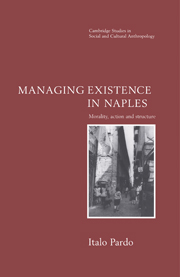Book contents
- Frontmatter
- Contents
- Preface
- Map 1 The province of Naples
- Map 2 The districts of Naples
- 1 Issues of anthropological research in urban Europe
- 2 Beyond unemployment: work, morality and entrepreneurship
- 3 Entrepreneurial morality and ethics among the young: changing social and cultural relations
- 4 Acceptance vs. discernment: the morals of family, kinship and neighbourhood as resource options
- 5 Transgression, control and exchange: the rationality of the ambiguous and the liminal in life and death
- 6 The mass diffusion of contacts: redefined power relations, values of representation
- 7 The relation of agency to organization and structure: deconstructed polarizations at the grassroots of democracy
- Notes
- References
- Index
- Cambridge Studies in Social and Cultural Anthropology
1 - Issues of anthropological research in urban Europe
- Frontmatter
- Contents
- Preface
- Map 1 The province of Naples
- Map 2 The districts of Naples
- 1 Issues of anthropological research in urban Europe
- 2 Beyond unemployment: work, morality and entrepreneurship
- 3 Entrepreneurial morality and ethics among the young: changing social and cultural relations
- 4 Acceptance vs. discernment: the morals of family, kinship and neighbourhood as resource options
- 5 Transgression, control and exchange: the rationality of the ambiguous and the liminal in life and death
- 6 The mass diffusion of contacts: redefined power relations, values of representation
- 7 The relation of agency to organization and structure: deconstructed polarizations at the grassroots of democracy
- Notes
- References
- Index
- Cambridge Studies in Social and Cultural Anthropology
Summary
In the congested midmorning traffic of the busy centre of Naples, a man speeds on a moped bearing stickers of the Volto Santo (Holy Face of Christ) and of the Naples football team's mascot. Various logos adorn the expensive helmet which, instead of being worn as prescribed by law, hangs from the back of the moped. Probably in his early forties, the man wears fashionable jeans, shirt and trainers. Suddenly he brakes to shout and exuberantly gesture a respectful greeting to a dottore who is negotiating his way along the sidewalk among cars half-parked on the pavement, other pedestrians and street-vendors' improvised stalls and show-rugs. Without stopping, the dottore acknowledges the greeting, waving his briefcase-free hand. Under the wisely inattentive eye of a bored, perhaps stressed vigile (pl. vigili, watchman), the man U-turns in the one-way street and, having quickly parked and locked the moped, approaches the dottore. The minor disturbance is speedily absorbed by the apparently chaotic but in fact virtually self-regulating stream of traffic. Speaking gently, touching the dottore's arm, the man coaxes him towards a fashionable bar nearby. A quick coffee, a concerned chat, and the brief encounter is over; the moped-rider joins his mates standing by, and the professional enters a building.
The dottore and the moped-rider are a council bureaucrat and a council manual worker. They meet near the comune (town hall), but similar encounters can easily be observed near any public building or central place of leisure.
- Type
- Chapter
- Information
- Managing Existence in NaplesMorality, Action and Structure, pp. 1 - 18Publisher: Cambridge University PressPrint publication year: 1996

